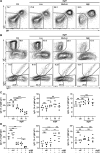This is a preprint.
BCR ligation selectively inhibits IgE class switch recombination
- PMID: 39345367
- PMCID: PMC11429801
- DOI: 10.1101/2024.09.18.613749
BCR ligation selectively inhibits IgE class switch recombination
Abstract
Mechanisms that restrict class switch recombination (CSR) to IgE limit the subsequent production of IgE antibodies and therefore the development of allergic disease. Mice with impaired B cell receptor (BCR) signaling have significantly increased IgE responses, consistent with a role for BCR signaling in IgE regulation. While prior work focused on BCR signaling in IgE-expressing cells to explain these findings, it has been reported that BCR signaling can reduce CSR. Therefore, we investigated the possibility that IgE CSR might be particularly sensitive to inhibition by BCR signaling in unswitched B cells. We found that immunization of mice with high-affinity antigen resulted in reduced representation of IgE-expressing cells among germinal center B cells and plasma cells relative to a low-affinity antigen. Mechanistic experiments with cultured mouse B cells demonstrated that BCR ligands selectively inhibited IgE CSR in a dose-, affinity-, and avidity-dependent manner. Signaling via Syk was required for the inhibition of IgE CSR following BCR stimulation, whereas inhibition of the PI3K subunit p110δ increased IgE CSR independently of BCR ligation. The inhibition of IgE CSR by BCR ligands synergized with IL-21 or TGFβ1. BCR ligation also inhibited CSR to IgE in human tonsillar B cells, and this inhibition was also synergistic with IL-21. These findings establish that IgE CSR is uniquely susceptible to inhibition by BCR signaling in mouse and human B cells, with important implications for the regulation and pathogenesis of allergic disease.
Figures






Similar articles
-
B cell TLR1/2, TLR4, TLR7 and TLR9 interact in induction of class switch DNA recombination: modulation by BCR and CD40, and relevance to T-independent antibody responses.Autoimmunity. 2015 Feb;48(1):1-12. doi: 10.3109/08916934.2014.993027. Autoimmunity. 2015. PMID: 25536171 Free PMC article.
-
B cell receptor ligation induces IgE plasma cell elimination.J Exp Med. 2023 Apr 3;220(4):e20220964. doi: 10.1084/jem.20220964. Epub 2023 Feb 28. J Exp Med. 2023. PMID: 36880536 Free PMC article.
-
TRAF3 Acts as a Checkpoint of B Cell Receptor Signaling to Control Antibody Class Switch Recombination and Anergy.J Immunol. 2020 Aug 1;205(3):830-841. doi: 10.4049/jimmunol.2000322. Epub 2020 Jun 26. J Immunol. 2020. PMID: 32591397 Free PMC article.
-
Signaling control of antibody isotype switching.Adv Immunol. 2019;141:105-164. doi: 10.1016/bs.ai.2019.01.001. Epub 2019 Feb 11. Adv Immunol. 2019. PMID: 30904131 Free PMC article. Review.
-
Intrinsic and extrinsic regulation of IgE B cell responses.Curr Opin Immunol. 2021 Oct;72:221-229. doi: 10.1016/j.coi.2021.06.005. Epub 2021 Jun 30. Curr Opin Immunol. 2021. PMID: 34216934 Free PMC article. Review.
References
-
- Omori S. A. et al. Regulation of Class-Switch Recombination and Plasma Cell Differentiation by Phosphatidylinositol 3-Kinase Signaling. Immunity 25, 545–557 (2006). - PubMed
Publication types
Grants and funding
LinkOut - more resources
Full Text Sources
Miscellaneous
